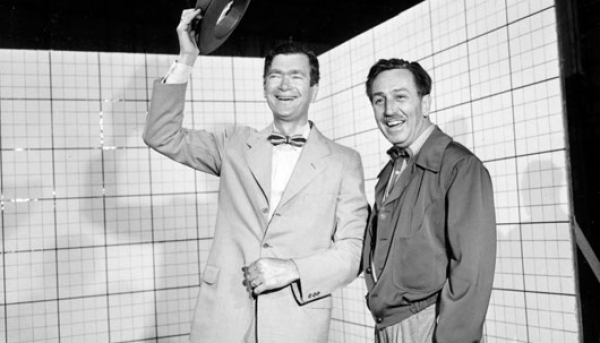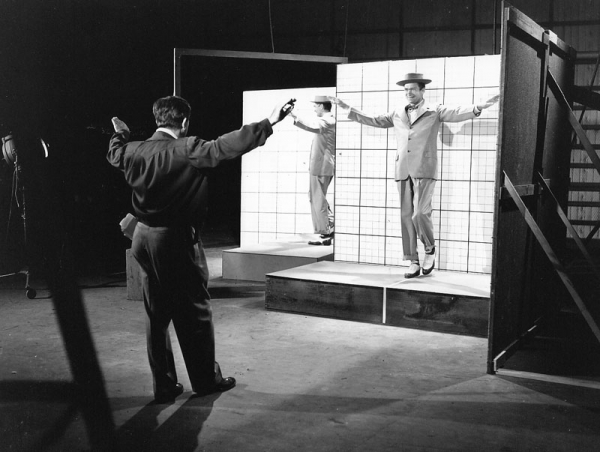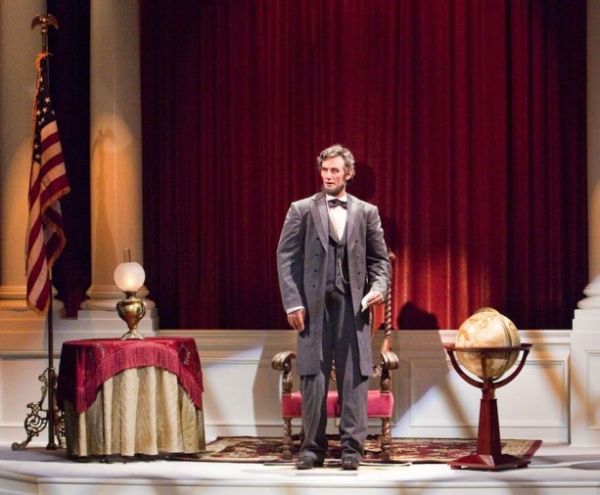Yes, he’s the guy who played Jed Clampett
Image: Disney
Of course, for that tomorrow to come, Adams must decipher the underlying mechanics of a strange toy. He had an advantage, though. Disney Imagineers were early pioneers in the field of electrical animation already. Adams felt confident he could design and engineer lifelike electronic devices that could display human traits if he had enough time to work on the system.
To achieve this admirable goal, Adams returned to a recent company experiment. Other staff members named Wathel Rogers and Roger Broggie received a similar assignment from their Uncle Walt. He asked them to perform a similar technological breakdown of another emerging technology. An inventor had proved that by sending a series of pulses to an electronic tape, the closest thing to hard drive technology in the era, he could cause an electrically operated device to move.
Rogers and Broggie set out to recreate this experiment using a test subject. Disney himself recommended an accomplished dancer whom he’d used many years before. That man’s movements had performed a baseline model for the movements of Mickey Mouse during the 1920s and 1930s.
Disney admired the dancer and kept in touch over the years. When the opportunity presented itself to employ the man once again, he happily did so. The artist showed up and performed a detailed soft shoe routine. Rogers and Broggie recorded the entire performance and thanked the man for his time. Soon afterward, Disney himself showed his gratitude by casting the man who also acted in a key role in the company’s upcoming television production, Davy Crockett.
Davy Crockett was the Star Wars of the mid-1950s in terms of toy sales, and the show’s continued popularity led to one Buddy Ebsen becoming an in-demand television star. And that name should sound familiar to you, as, he was Jed Clampett on The Beverly Hillbillies. Who knew he could dance? For more information about Ebsen, you should read his Wikipedia page. The section on The Wizard of Oz will blow your mind, even if it’s not Disney related.
Singing Birds and a Dancing Man
Rogers and Broggie used Ebsen’s toe tapping skills to create something they called The Dancing Man. They developed the ability to control its movements as if it were a puppet capable of pulling its own string. Their boss felt confident that they were on to something big. Even he couldn’t have understood the full import of this research and development proposition, though.
What the Disney engineers and electrician learned qualified as computer technology, at least for the 1950s. Through trial and error, they discovered that the inventor of the singing bird toy had led them down the path toward a major scientific breakthrough.
Magnetic tape is a technology people over 30 actually know quite well. Your pre-mp3 mix tapes were called cassettes, but they employed the same underlining concept, only repurposed for music. They held a specific sequence of stored information. Pushing the various buttons on your Boombox (Google it, kids) would cause the magnetic tape to perform a designated task. It was high-functioning magnetic-tape-based computer system, at least of a kind.
The Imagineers advanced the concept of artificial manipulation of inanimate objects through a series of programmable functions. Buddy Epsen’s foot functions paved the way. The three men tested the Dancing Man in novel ways, attempting to audio-animate each of his precise moments. The aforementioned pulse sequences could trigger literally thousands responses in the otherwise lifeless machine. They learned repeating tape could store enough data for an entire dancing sequence and, eventually, an entire show.
Disney could also output hundreds of these sonic waves in a single second. It was this revelation that led to the invention of the company’s first true Audio-Animatronic (AA), the legendary singing birds in The Enchanted Tiki Room. It went live in 1963. By this point, WED Enterprises, the Disney engineering team, had already patented the technology.
Disney goes all-in on the technology
Image: Disney
The 1964 New York World’s Fair advanced and elevated public awareness of AAs. Guests from across the globe demonstrated awe at the new invention. The Illinois Pavilion’s masterwork was Great Moments with Mr. Lincoln. It was so life-like that the inanimate object brought numerous audience members as it recreated Lincoln’s motions simultaneously with his speeches. At this point, all involved knew that AAs were a future staple of Disneyland.
Walt Disney possessed a distinct point of view on the subject. A natural born showman, he always considered everything in Hollywood terminology. Disney attractions were the stages, and how Imagineers built these sets defined a theme park tourist’s enjoyment of the proceedings. AAs added a newfound level of realism to the exhibitions. These shows would include performers who never missed their mark, never coughed during a show, and never once forgot their lines. To Disney’s mind, they were the perfect thespians. Here’s how he described the technology to writer Kathy Merlock Jackson in her book, Walt Disney: Conversations:
“After we get (the AA), we get it programmed. It’s like rehearsing a show when you go through it and rehearse it and rehearse it and you finally say, “That’s it!” We say, “All right, let’s go for a take.” All the things we do here are recorded, and then when we play the tape back he will do everything he is doing here. Only it is all part of a programmed show, you see.”
Disney added that he had no intention for AAs to replace human thespians or other Disney cast members. That wasn’t the purpose he envisioned for his new hybrid android. Instead, he noted the benefits from a business perspective. With AAs, he felt they could perform on demand. In Walt’s words:
“We operate 15 hours a day. And these shows have to go on the hour. And my Tiki bird show goes on three times an hour, and I don’t have to stop for coffee breaks, and all that other kind of stuff, you see. So that’s the whole idea of it. It’s just another dimension in the animation we have been doing all our life. It’s a dimensional thing and it’s a new door. It’s a new toy for us and we are having a lot of fun. We hope we can really do some exciting things in the future.”
The wording he chooses is umambiguous All of the timeless Walt Disney animated classics included a fatal flaw that bothered their creator. The illustrations existed in only two dimensions. AAs offered the promise of a better type of storytelling, one with literally and figuratively more depth. Pictures on a screen could only do so much for Disney. The AA of Abraham Lincoln, on the other hand, could cause audience members to suspend disbelief long enough to acknowledge that maybe, just maybe, they would accept that the 16th President of the United States was standing in front of them, delivering one of his most famous speeches. Disney was correct about the choice, just as he was about how impactful this technology could be for telling pirate tales.




Add new comment